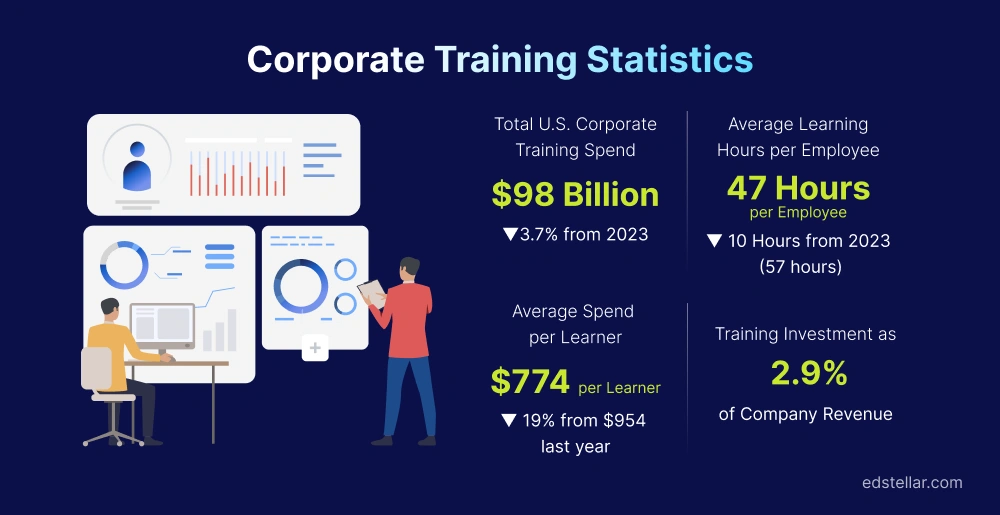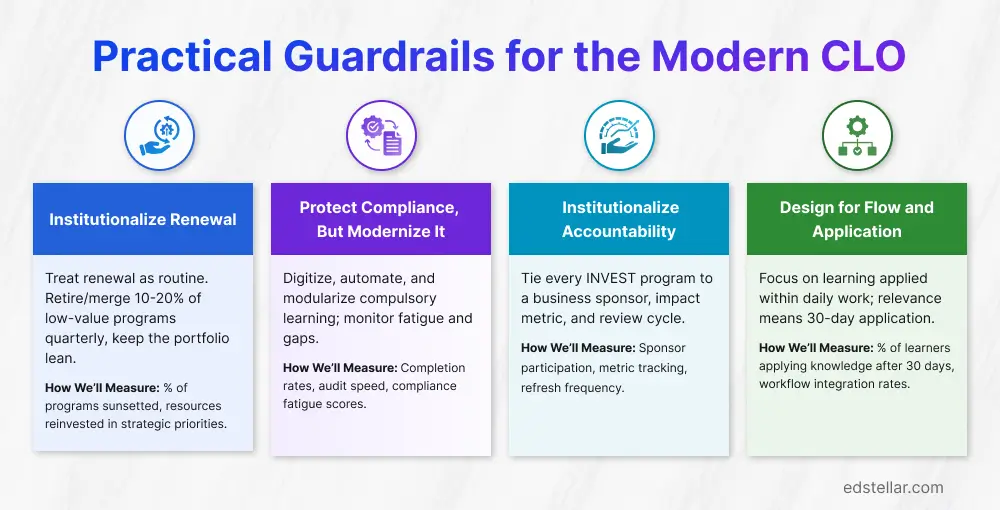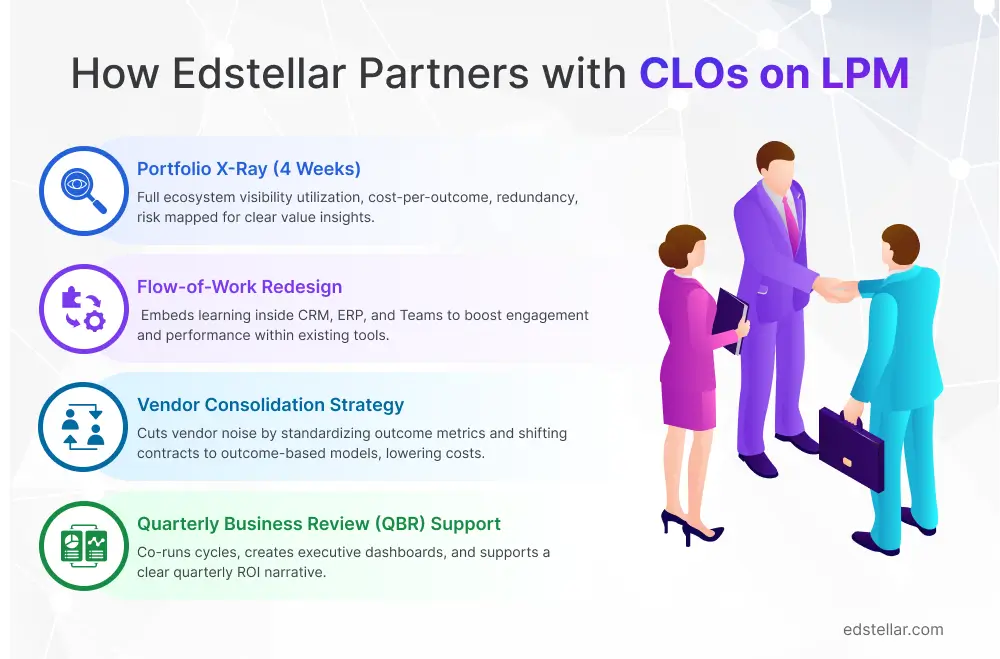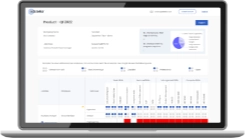
Every Chief Learning Officer now walks into the budget review with the same question echoing across the table: “What are we really getting for all this learning spend?”
The numbers make that question impossible to ignore. According to the 2024 Training Industry Report, U.S. corporate training expenditures fell 3.7% to $98 billion, while employees logged 10 fewer learning hours, and per-learner investment dropped nearly 19%. Budgets are shrinking, but scrutiny isn’t. The C-suite no longer rewards volume; it demands evidence that learning is moving business performance, and in 2026, that expectation has become non-negotiable.

And that’s where the real tension lives. Beneath the surface of glossy dashboards lies a sprawling learning catalog that is redundant, underutilized, and often misaligned with enterprise strategy. In most organizations, multiple business units fund similar programs in silos: three versions of “leadership fundamentals,” five vendors teaching the same skill. Most teams have good intentions, but few have a structured process for retiring legacy programs or consolidating overlap. Without clear ownership, programs linger long after their impact fades.
This isn’t a content problem. It’s a capital problem disguised as a learning one.
Learning Portfolio Management (LPM) changes that. It brings CFO-grade capital discipline to learning by treating every program as an investment competing for limited capital. Each one is judged by clear signals: strategic fit, utilization, cost per outcome, and verified business impact.
With LPM, the CLO moves from defense to direction, from explaining spend to reallocating capital where capability grows fastest. From content to capability. From activity to results. From nice-to-have to non-negotiable. From reporting hours to proving return.
Why Portfolio Rationalization is a Non-Negotiable
For years, L&D success was measured by scale: more content, more hours, more access. It built visibility, but not necessarily value. What once symbolized progress has quietly become complexity.
The old model no longer fits the world we’re operating in. Because the shelf life of skills is collapsing, AI is reshaping work faster than most curricula can keep up, and every function, from finance to operations, is being held to measurable ROI. Learning can’t be the exception.
Executives have already reset their expectations. According to reports, the top four priorities for L&D are effectiveness (30%), usage (22%), efficiency (16%), and measurement (16%). The pattern is clear: the mandate has shifted from delivery to discipline.
If skills are the new currency, then portfolio rationalization is how a CLO manages its value. It’s the process of ensuring that every dollar, hour, and platform strengthens enterprise capability instead of sustaining programs that no longer produce returns. The goal isn’t contraction; it’s conversion: turning spend into performance and effort into evidence.
That’s why rationalization has moved from a smart idea to a strategic necessity. It provides the system L&D has long lacked, a way to judge programs by impact, not inertia; to retire with purpose, redesign with precision, and reinvest with confidence.
For CLOs, this marks a shift from managing learning to managing capital for growth. And the tool that makes it operational, the framework that brings that discipline to life, is Learning Portfolio Management.
The LPM Framework: Treat Your Catalog Like a Product Portfolio
A CLO’s portfolio isn’t just a list of courses; it’s a balance sheet of capability.
Every line item represents capital: invested, underperforming, or waiting to be redeployed.
Learning Portfolio Management (LPM) gives you the discipline to treat each program like an asset, measured not by activity but by enterprise return.
A report by Brandon Hall Group indicates that “the largest allocation of the budget goes to headcount” and that leadership development consumes a significant portion of L&D spend.
These essentials are necessary, but they leave limited flexibility for innovation and capability-building initiatives. The real opportunity lies in the discretionary layer, the hundreds of smaller programs that quietly consume budget without clear accountability.
That’s where LPM goes to work, replacing opinion-based decisions with evidence-backed clarity.
LPM evaluates every program through five critical signals, the ones that reveal whether it deserves investment, redesign, or retirement.
1. Strategic Fit
When everything feels important, what truly deserves funding?
The first signal asks whether a program directly advances a business priority or builds a role-critical capability.
Programs that accelerate growth, readiness, or mobility rise to the top. Those that don’t align with the strategy or have lost sponsorship belong under review.
2. Utilization & Reach
If it’s not being used, it’s not delivering.
LPM looks beyond completion rates to assess adoption inside critical roles. Are the right people learning the right things, at the right time, in the flow of work?
When high-value programs show low penetration, the issue isn’t content, its relevance, or accessibility.
3. Cost per Outcome
Every learning dollar should earn its keep.
This signal compares investment against verified results, cost per learner, per certification, or per reduction in ramp-up time.
Patterns here expose silent inefficiencies: expensive programs that survive out of habit, not evidence. The goal isn’t to cut costs, but to continuously improve the return curve of your portfolio.
4. Business Impact Evidence
Learning that doesn’t move a KPI is activity, not impact.
The strongest programs show a measurable link to business outcomes, such as higher sales conversion, shorter ramp-up, fewer safety incidents, or improved NPS.
When impact is defined with business sponsors upfront, learning shifts from a service function to a strategic performance driver.
5. Delivery Risk & Scalability
Even strong programs lose value if they can’t evolve with the business.
LPM helps you assess whether a program is built to last or built to break. It evaluates factors such as vendor dependency, technology shelf life, delivery modality, and data reliability.
Programs that rely on a single vendor, outdated platforms, or limited formats quietly become budget liabilities, expensive to maintain, hard to update, and risky to scale. Rationalization exposes these fragilities early, ensuring your portfolio stays resilient and ready for what’s next.
Your Decisive Tool: The Portfolio Rationalization Scorecard
After evaluating programs through the five LPM signals, the Portfolio Rationalization Scorecard turns insight into action. It replaces intuition with data-driven clarity, assigning weighted scores across key dimensions such as strategic fit, impact evidence, utilization, efficiency, and scalability to produce a clear investment decision.

What you see here isn’t just a visualization, it’s governance in motion. The scorecard gives CLOs a transparent, defensible way to determine which programs deserve continued investment, which require redesign, and which should be retired. When presented to the C-suite, it becomes your proof of capital discipline, a snapshot of where learning truly drives performance.
With this tool, portfolio rationalization stops being an audit; it becomes a governance system. It’s how learning leadership proves not just accountability, but stewardship.
The 90-Day Operating Rhythm for Continuous Rationalization
Learning portfolios don’t stay optimized on their own. Priorities shift, technologies evolve, and new initiatives emerge faster than old ones are retired.
That’s why high-performing CLOs don’t treat portfolio rationalization as a one-time audit. They run it as a 90-day operating rhythm. Every quarter becomes a disciplined cycle of reflection, reprioritization, and reinvestment that keeps the catalog lean, current, and aligned with enterprise goals.
Weeks 1–3: Inventory and Baseline Building the Truth
Every great decision starts with visibility. The first three weeks are about mapping reality and creating a single, trusted view of where your learning dollars and learner attention actually go.
During this phase, the team compiles every active program, vendor contract, and audience segment, linking each to the business KPI it claims to influence. It’s less about judging value and more about surfacing what exists and who owns it.
By week three, you’ll have your portfolio register, a living document that shows every learning investment, its owner, spend, audience reach, and purpose. This becomes your single source of truth, replacing scattered spreadsheets and assumptions with a clear foundation for every future decision.
Weeks 4–6: Score and Classify Turning Insight into Evidence
Once the inventory is complete, the next phase brings discipline. Using the LPM Scorecard, you now evaluate each program across consistent dimensions such as strategic alignment, impact evidence, utilization, cost efficiency, and scalability.
The goal is to move beyond opinion and create a defensible classification that shows which programs earn continued investment, which hold potential but need redesign, and which are past their shelf life.
Patterns emerge quickly: redundant vendor offerings, underperforming legacy programs, and high-impact initiatives that deserve more attention.
By the end of week six, you’ll have a portfolio heatmap that tells a clear story of where learning drives measurable outcomes and where it merely consumes resources. It’s not just data; it’s direction.
Weeks 7–9: Reallocate and Redesign Making the Hard Calls
This is where the work becomes transformation.
With your portfolio map in hand, you start to act on it, redirecting resources from sunset programs to those proven to deliver business impact.
Low-value initiatives are phased out or merged, freeing budget and bandwidth. For fix programs, the focus shifts to redesign, embedding them into the flow of work through tools employees already use, such as CRM, ERP, or Teams. When learning is frictionless and contextual, adoption soars, and the business begins to feel the change.
By week nine, the portfolio starts to breathe differently. You’ve trimmed noise, clarified priorities, and rebalanced effort toward what actually drives capability and performance.
Weeks 10–12: Review and Refocus Closing the Loop
The final stretch is about alignment and storytelling, translating operational clarity into executive confidence.
Here, the CLO and leadership team review a single-page dashboard that plots spend against impact scores, showing what was invested, redesigned, or retired. The narrative is no longer about activity but about outcomes, proof of efficiency, impact, and reinvestment.
This review locks in next-quarter priorities and solidifies governance rhythms. By week twelve, the organization isn’t just running learning programs; it’s managing a live portfolio of investments that reflect strategy, not inertia.
Each quarter begins and ends with the same discipline: visibility, evidence, action, and accountability. That’s how LPM turns learning from a cost center into managed capital and how CLOs prove that fiscal rigor and human development can coexist.
Anticipating CFO Objections (And How to Win)
Every Chief Learning Officer eventually faces the same meeting. A quiet boardroom. A spreadsheet is open.
The CFO looks up and asks, “So what are we really getting for all this learning spend?”
It’s not hostility; it’s due diligence. The CFO’s job is to manage capital. Yours is to prove that learning deserves to be treated as one.
When handled with clarity, this moment can shift perception from expense to investment, from defense to partnership. Here’s how the strongest CLOs win that conversation.
1. “Show Me Outcomes, not Enrollments.”
CFOs don’t care how many people completed a module. They care about what changed afterward.
Replace vanity metrics with business deltas: higher sales conversion, faster time to productivity, fewer safety incidents, improved customer satisfaction.
Show before-and-after comparisons using consistent cohorts and link every data point to cost per verified outcome. The message: learning doesn’t just educate; it accelerates performance.
2. “There’s too Much Vendor Overlap.”
From a finance perspective, redundancy equals waste.
Use your portfolio view to demonstrate consolidation potential by identifying duplicated content, overlapping platforms, and redundant contracts. Present a supplier rationalization plan tied to measurable savings and quality improvement, backed by LPM scorecard data.
This reframes the narrative: not “cutting costs,” but “protecting capital efficiency.”
3. “Usage is too Low.”
Low participation signals poor ROI to any CFO. But usage often drops not because programs lack relevance, but because they lack accessibility.
Show how embedding learning into daily systems, CRM, ERP, or Teams, drives higher completion and on-the-job application. Make the case that integration, not volume, drives utilization and value realization.
4. “What’s the Benchmark?”
CFOs benchmark everything, and learning should be no exception.
Reference credible anchors: 47 hours of total learning per employee (Training Magazine, 2024) and 13.7 formal hours per employee with 2.9% of revenue invested in learning (ATD, 2026).
Then pivot to your differentiator: while most organizations track hours, you track dollars per verified outcome. That’s the language of capital performance, and it’s how learning earns its place on the balance sheet.

The Leadership Operating Code for Modern CLOs
Running L&D with enterprise-level discipline isn’t just about cutting waste; it’s about protecting credibility.
In a volatile business landscape, these four disciplines form the operating code that keeps the learning portfolio sharp, strategic, and future-ready.

1. Institutionalize Renewal
Neglect renewal, and your portfolio stagnates under its own weight.
High-performing CLOs don’t wait for obsolescence; they institutionalize it. Every quarter, they retire or merge 10–20% of low-value programs, freeing capital for what’s next.
The signal of maturity isn’t how much learning you add; it’s how decisively you let go. Renewal keeps your portfolio alive, adaptive, and aligned with strategy, not nostalgia.
2. Protect Compliance, but Modernize Relentlessly
Compliance will always claim its share of the budget. The mistake is letting it claim your learners’ attention.
Modern CLOs digitize, automate, and modularize mandatory learning so it’s fast, verifiable, and fatigue-free.
Analytics track completion, audit speed, and engagement health. The goal isn’t just risk avoidance, it’s credibility at scale: compliant, efficient, and humane.
3. Institutionalize Accountability
Every INVEST program must have an accountable business sponsor, a measurable outcome, and a review cadence that matches enterprise reporting.
When ownership lives solely in L&D, learning stays a service. When it’s shared with business units, it becomes a lever.
Governance isn’t bureaucracy; it’s the operating rhythm that turns programs into proof points and sponsors into advocates.
4. Design for Flow, Measure by Application
The ultimate test of relevance isn’t attendance; it’s application.
If employees aren’t using what they learn within 30 days, the program isn’t relevant; it’s noise.
Prioritize interventions that live inside daily systems, CRM, ERP, or Teams, where behavior changes naturally. The KPI shifts from completions to conversions: how learning translates into performance.
From Complexity to Clarity: How CLOs Operationalize LPM with Edstellar
Every Chief Learning Officer knows the tension: the pressure to show measurable business impact while wrestling with sprawling programs, vendor noise, and inconsistent data.
You can feel the potential of learning to power performance, but the portfolio often feels heavy, fragmented, and hard to defend.
That’s where Edstellar steps in as a systems partner, helping you turn complexity into clarity and execution into evidence.

1. Portfolio X-Ray: Seeing the Whole Picture
Every transformation starts with visibility.
In just four weeks, the Portfolio X-Ray gives you a single, data-backed view of your entire learning ecosystem utilization, cost-per-outcome, redundancy, and risk.
For many CLOs, it’s the first time the full portfolio becomes visible on one dashboard: what’s driving capability, what’s duplicating effort, and what’s silently draining capital.
2. Flow-of-Work Redesign: From Participation to Performance
Once you see where value lives, momentum shifts to design.
Together, we embed priority learning inside the tools your workforce already uses: CRM, ERP, and Teams.
No extra platforms. No added friction.
Learning moves from “something to attend” to “something that accelerates work.” Engagement rises, and so does measurable performance.
3. Vendor Consolidation Strategy: Simplify Without Sacrifice
Visibility often reveals overlap.
We help you cut noise, not capability, by identifying redundant vendors, standardizing metrics, and renegotiating contracts around outcomes, not activities.
Across enterprises, this process typically frees 15–25% of learning spend for reinvestment without losing reach or quality.
Fewer vendors. Stronger governance. Clearer returns.
4. Quarterly Business Review Support: Turning Data into Credibility
Data becomes real when it shapes the next decision.
Each quarter, Edstellar co-runs your Invest / Fix / Sunset cycles, prepares executive-ready dashboards, and helps craft a C-suite narrative around verified outcomes.
What was once a defensive budget review becomes a proactive story of reinvestment, return, and readiness.
You stop explaining learning, and you start governing it.
With Edstellar, LPM becomes more than a framework; it becomes your governance system.
You gain the clarity to see what matters, the cadence to keep it current, and the confidence to prove that every learning dollar delivers measurable enterprise value.
Final Thoughts
The mandate for the modern CLO has never been sharper or more vital.
You’re no longer defending budgets; you’re directing enterprise capability.
Learning Portfolio Management is the discipline that makes that shift real. It’s how intent turns into impact, programs into performance, and learning investments into measurable competitive strength.
When managed with structure and transparency, your portfolio becomes proof of leadership. Proof that learning can operate with the same fiscal rigor, precision, and accountability as any capital function in the business.
That’s where Edstellar stands beside you, helping you operationalize this system, build the governance that sustains it, and turn every review into evidence of return.
Because when a CLO leads with clarity, the business doesn’t just learn, it compounds capability.
Explore High-impact instructor-led training for your teams.
#On-site #Virtual #GroupTraining #Customized

Bridge the Gap Between Learning & Performance
Turn Your Training Programs Into Revenue Drivers.
Schedule a ConsultationEdstellar Training Catalog
Explore 2000+ industry ready instructor-led training programs.

Coaching that Unlocks Potential
Create dynamic leaders and cohesive teams. Learn more now!


Want to evaluate your team’s skill gaps?
Do a quick Skill gap analysis with Edstellar’s Free Skill Matrix tool

Transform Your L&D Strategy Today
Unlock premium resources, tools, and frameworks designed for HR and learning professionals. Our L&D Hub gives you everything needed to elevate your organization's training approach.
Access L&D Hub Resources.svg)
.svg)



.svg)



.svg)
.svg)
.svg)
.svg)

